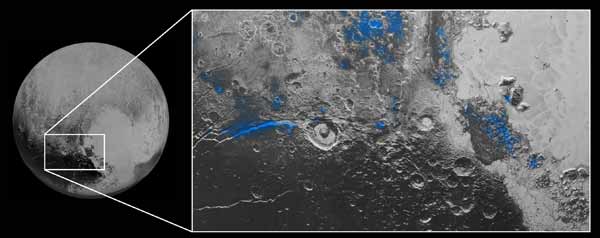
California, US (BBN)-Planetary scientists have suspected for months the presence of water on Pluto in the form of towering ice mountains, some of which rival Earth's Rocky Mountains in height.
But it wasn't until recently that they had solid proof, and the discovery is raising intriguing questions about the color and location of the water ice, reports The Business Insider.
The latest images of Pluto, released on Thursday, are the first to reveal patches of frozen water on its surface.
And adding to the growing list of Pluto mysteries, neither the color nor location of water ice on Pluto is what the scientists were expecting.
The most recent photo, shown below, offers an especially intriguing view of both the oldest and newest surfaces on Pluto: To the left of the close-up shot is the most heavily cratered region on Pluto, which scientists suspect is extremely old.
The false colors in the image above help scientists differentiate between the water ice on Pluto and the other ices, such as nitrogen, methane, and carbon-dioxide ice.
In reality, the water ice on Pluto is red, not blue like in the photo or clear like it is here on Earth.
And scientists are dumbfounded as to why.
"I'm surprised that this water ice is so red," Silvia Protopapa, a New Horizons team member, said in a NASA press release.
"We don't yet understand the relationship between water ice and the reddish tholin colorants on Pluto's surface."
The "tholin colorants" that Protopapa is referring to are a type of molecule that are generally red in color and form when organic compounds — which have nothing to do with life in this case — are blasted with ultraviolet light from the sun.
Pluto's atmosphere is rich with tholins, but whether the red-tinted water ice on Pluto's surface contains any of them remains an unanswered question.
Another mystery concerning water ice on Pluto is its location.
When NASA's New Horizons spacecraft flew by Pluto on July 14, it focused on this intriguing part of the dwarf planet that has since mystified scientists as to how geologically diverse it is — with four mountain ranges, a vast expanse of craters, and smooth plateaus, Pluto is one of the most geologically diverse places in the solar system.
When scientists first saw the mountains on Pluto, their immediate conclusion was that the mountains must be made of water ice because that's the only kind of ice strong enough to support mountains over 10,000 feet tall.
But what about the other places?
There appears to be a vast expanse of ice in the mysterious crack featured on the far left and in the heavily cratered patch, called Viking Terra, to the north.
"Large expanses of Pluto don't show exposed water ice, because it's apparently masked by other, more volatile ices across most of the planet" Jason Cook, a New Horizons team member, said in NASA's press release for the latest images.
"Understanding why water appears exactly where it does, and not in other places, is a challenge that we are digging into."
Since its closest approach to Pluto, the New Horizons spacecraft has traveled an additional 500 million miles and is now 3.1 billion miles from Earth.
NASA reports that its systems are "healthy and operating normally."
BBN/SK/AD